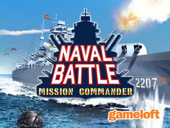By Brad Cook
You study the enemy’s position. Placid waters belie the fleet lurking there. You call out a coordinate: B-7. A missile screams overhead … and splashes into the waves as a pair of seagulls lazily circle overhead. The enemy then fires on your position, with the same result.
Once more you consider the grid. Perhaps their destroyer lies in wait near that island. You call out a new strike: D-2. This time, the missile finds a target. You direct the next attack at an adjacent square and once again hit paydirt. From there, you deduce the rest of the enemy ship’s location and sink their aircraft carrier. No more reconnaissance missions for them.
Now it’s time to unleash a special attack. You opt for a barrage from your battleship, launching a volley of missiles that land in a star-shaped pattern. Two hits reveal the location of additional enemy ships. You smile, knowing you will finish them off before they can fire at you again.
Four Variations on a Theme
Naval Battle: Mission Commander takes the classic board game Battleship to a new level, placing you in the role of an American, Scottish, Russian, or German skipper with eight different ships under your control as you take on a computer-controlled opponent or another player on the same iPod. Play through an 18-mission solo campaign or try one of three game modes: Original (one shot per turn; you get to shoot again if you hit the enemy); Salvo (one shot per turn for each ship still alive in your fleet); and Advanced (immediate access to all of the special attacks for the ships still alive in your fleet). Or select Instant Battle to play a random mission from the campaign.
Special attacks apply to every game mode but Salvo and Original. Each time you fire at the enemy, your special attack meter fills, more so if you’re successful. When it tops out, you can access the special attacks menu, which includes a missile barrage from your battleship, your minelayer’s ability to unleash magnetic mines, a submarine torpedo strike, and more. Not all of the eight special attacks are available during campaign missions, where the scenarios vary.
During a campaign, you also get the opportunity to hit bonus squares that improve your chances of victory. One might give you three turns in a row, while another lets you intercept an enemy transmission coming from a specific square, telling you where a ship sits. In addition, each mission awards you medals for performing specific deeds, such as sinking two boats in a row or firing 10 consecutive successful shots.
Many Goals
Naval Battle tracks the medals you’ve won, along with the highest rank you’ve attained so far and your success completing the secondary objectives found in each campaign mission. In the Career Record screen, peruse your cumulative point totals and see which mission was your best so far.
But don’t linger too long, because Russian commander Victor Watts waits in frigid Antarctic waters, his fleet using the cover of an iceberg to hide from you. Good luck.
It All Began With a Sheet of Paper and a Pencil
People have been playing variants of Naval Battle for around 100 years. Sometime before World War I, someone, somewhere — more likely, multiple serendipitous someones — drew a grid on a sheet of paper, assigned letters along one side and numbers along the other, and challenged an opponent to guess the locations of hidden boats.
The game not only caught on with schoolchildren, but historian John Toland notes in his 1963 book “The Dillinger Days” that when the legendary criminal John Dillinger served prison time during the 1920s, inmates played it. Toland writes: “For years the more obtuse guards wondered what was being plotted when they heard men calling: ‘B-7.’ ‘Miss.’ ‘C-8.’ ‘Destroyer sunk!’”
Many players created their own rules for the game, which first saw commercial publication in 1931 as Salvo. Milton Bradley, which was responsible for the version of the game that most people are familiar with, first published theirs as Broadsides, The Game of Naval Strategy in 1943. In 1967, the company turned Broadsides into Battleship, and through an aggressive advertising campaign featuring the phrase “You sunk my battleship!”, made it one of the top-selling board games of the 1970s and 1980s.
Today, Milton Bradley still publishes the traditional version of Battleship in multiple versions, along with an electronic edition that introduces advanced weaponry similar to the special attacks in Naval Battle. The company has also licensed the game for various Nintendo home console releases.
iPod Games FAQ
Do you have questions regarding any of the iPod games available from the iTunes Store?

Special Attack on the March. Use a barrage from your battleship to erupt the volcano.
- Site: Naval Battle
- Publisher: Apple Inc.
- Developer: Gameloft
- Genre: Strategy
System Requirements
- Mac OS X version 10.3.9 or Windows 2000
- iPod nano (3rd and 4th generation only), iPod classic, or iPod (5th generation only). Not playable on your computer, other iPod models, iPod touch or iPhone. Please check which iPod model you have.
- iTunes 7.5 or higher required to download (games cannot be played in iTunes)

